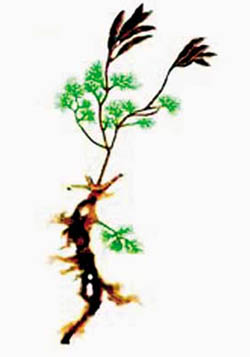The recovery image indicates that the Confucius bird looked like a "phoenix" in Chinese folklore, which is believed to represent a sign of a favorable future. The ancient Chinese fruit, parts of whose stem and roots are strips of needles, somewhat resembles present-day bean plant. Recovery of the prehistoric flower and bird help people acquire a better understanding of precious historical and cultural heritages.

Digital artistic rendering of the ancient Chinese fruit
Meanwhile, Mr. Zhao also made public his other recovery photos: the head of a statute of the goddess of Hongshan – China's earliest statute of a goddess discovered so far; the Chinese dragon bird; and a Liaoning ancient fruit, among other items. All are the world's cultural treasures.
Mr. Zhao, 65, has been working for many years in the criminal profiling research room of the Department of Forensic Medicine at the Chinese Criminal Police Institute. As the founder of China's study of criminal profiling, he once succeeded in providing important clues for the police around the country to solve cases.

Fossilized ancient Chinese fruit
In recent years, Mr. Zhao has explored and studied the technology of recovering ancient corpses. Using equipment for skull shape recovery in criminal profiling, he tries to recapture the corpse's appearance before death. He has recovered the appearance of over 20 ancient human and historical figures, including Mrs. Xin Zhui, a female corpse in the Han Tombs at Mawangdui, Changsha; Wu Cheng'en, the author of Journey to the West; and Loulan Beauty, Xiangfei (fragrant Imperial Concubine) in the Qing Dynasty, among others. This has attracted much attention from people both at home and abroad.
(China.org.cn by Wang Wei, June 19, 2008)